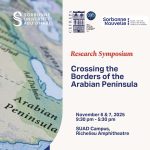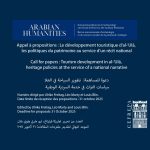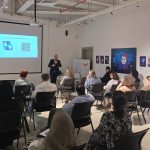AXIS I
Axis I
Archaeology of arabian peninsula
Coordination: Rémy Crassard (CNRS, CEFREPA)
Covering seven countries of the Arabian Peninsula (Kuwait, Yemen, Saudi Arabia, UAE, Sultanate of Oman, Bahrain and Qatar), CEFREPA’s geographical competence is one of the largest among those of French research centers abroad. It is also therefore rich and varied, covering periods ranging from prehistory to the Islamic period. Started in 1982 thanks to the creation of the French Center for Yemeni Studies (CFEY), which became the French Center for Archeology and Social Sciences in 2001 (CEFAS) then the French Center for Research in the Arabian Peninsula (CEFREPA) in 2021,
activity in archeology has gradually led researchers to take an interest in a wider geographical field, marked by civilizational characteristics specific to each part of this immense territory that is the Arabian Peninsula, but also by very strong links between different regions that make it up. From the civilization of Dilmun on the east coast of the peninsula to that of the Nabataeans in northern Arabia, and passing through the kingdoms of Saba in the south or Himyar in the southern part, this geographical unit has seen a succession, from the Neolithic, several settlements and forms of organization of space, while having established strong links with neighboring civilizations, in particular that of Mesopotamia, then the Persians and the Romans.
To interpret the vestiges of a past ranging from prehistory to the beginning of Islam, passing through the Bronze Age, the Iron Age and Antiquity, the various archaeological projects mobilize several disciplinary skills such as knowledge specific to ceramists, geographers, experts in hydraulic systems, numismatists, epigraphists, historians, geographers, botanists, restorers, topographers or draftsmen. Thanks to the cooperation of these disciplines, archeology manages to approach the human past as a total fact, of which all the variations and manifestations must be questioned. At the same time, the various projects, despite the specificities that set them apart, take into account, in the interpretations proposed, sometimes very extensive chronological sequences, ranging from the Neolithic to the Islamic period. The choice to work over the long term has proven to be fruitful in advancing knowledge of the history of the occupation of places and the management of resources by men. This is a relevant choice which brings a better knowledge of the stages of the evolution of the societies which succeeded one another within this immense space which is the Arabian Peninsula.
The projects carried out over the past few years have already revealed certain secrets, and no doubt have some nice surprises in store for us in the years to come. The discovery of the Camel Site in Saudi Arabia in 2016, the updating of the stages of the appearance of the caravan kingdoms in certain regions, as well as the better knowledge of the anthropological dimensions linked to the organization of the space between rites, artisanal productions , dwellings and the exercise of power: all these scientific advances lead us to abandon certain received ideas about pre-Islamic Arabia, and to no longer consider its history as synonymous with emptiness and aridity, like the desert which makes up a good part of it. On the contrary, the archaeological work shows the refinement of the material cultures present in the region (ceramics, drawings, architectural motifs, etc.), which breaks with the image of a rustic space, devoid of knowledge carried by men. The discovery of sites, graffiti, rock engravings or monumental sculptures shows to what extent the peoples present in the region have produced a material culture of great finesse. These aspects are corroborated by works on linguistic practices which underline the important presence of writing, something to which we did not pay attention by assimilating this space to the reign of orality. Thus, several inscriptions or graffiti in Arabic, Latin, Greek, South Arabian, Syriac, Aramaic or Nabataean make it possible to question the linguistic cultures which succeeded one another in this space, and to study the exchanges and borrowings that peoples may have had from different periods of their presence in this territory.
The new knowledge we now have thanks to the excavations and the resulting publications show how this space was at the heart of the human adventure, from the Neolithic to the Islamic period. It is clear that we are dealing with a space that was before the letter “connected” by trade, exchanges, the borrowing of architectural motifs, the adoption of artistic models, and the sharing of technical inventions. All this makes them complex objects of study, which force questions and oblige us to revise commonly accepted ideas, even to upset certain theses which, thanks to this new research, have become false or obsolete. Undeniably, this region was marked by the presence of several cultures that intersected, influenced each other and produced something unique. This makes it a heritage of considerable richness composed of several strata and crossed by many layers.
The recent focus on medieval and modern archeology also contributes to diversifying the activities of researchers, formerly centered on the ancient period, even the Paleolithic and the Neolithic. This openness to so-called “Islamic” archeology involves significant scientific and diplomatic issues, given the role it plays in the construction of national identities and in research and debates on the history of the beginning of Islam, which is experiencing significant expansion in the field of French Islamology. Beyond the interdisciplinary or multidisciplinary perspectives offered by this field of research, the projects carried out in the seven countries covered by CEFREPA have an identity that sets them apart and gives them specific objectives pursued during the excavations and the study of the explored sites. This is why the description of the different projects below is given by country.
To interpret the vestiges of a past ranging from prehistory to the beginning of Islam, passing through the Bronze Age, the Iron Age and Antiquity, the various archaeological projects mobilize several disciplinary skills such as knowledge specific to ceramists, geographers, experts in hydraulic systems, numismatists, epigraphists, historians, geographers, botanists, restorers, topographers or draftsmen. Thanks to the cooperation of these disciplines, archeology manages to approach the human past as a total fact, of which all the variations and manifestations must be questioned. At the same time, the various projects, despite the specificities that set them apart, take into account, in the interpretations proposed, sometimes very extensive chronological sequences, ranging from the Neolithic to the Islamic period. The choice to work over the long term has proven to be fruitful in advancing knowledge of the history of the occupation of places and the management of resources by men. This is a relevant choice which brings a better knowledge of the stages of the evolution of the societies which succeeded one another within this immense space which is the Arabian Peninsula.
The projects carried out over the past few years have already revealed certain secrets, and no doubt have some nice surprises in store for us in the years to come. The discovery of the Camel Site in Saudi Arabia in 2016, the updating of the stages of the appearance of the caravan kingdoms in certain regions, as well as the better knowledge of the anthropological dimensions linked to the organization of the space between rites, artisanal productions , dwellings and the exercise of power: all these scientific advances lead us to abandon certain received ideas about pre-Islamic Arabia, and to no longer consider its history as synonymous with emptiness and aridity, like the desert which makes up a good part of it. On the contrary, the archaeological work shows the refinement of the material cultures present in the region (ceramics, drawings, architectural motifs, etc.), which breaks with the image of a rustic space, devoid of knowledge carried by men. The discovery of sites, graffiti, rock engravings or monumental sculptures shows to what extent the peoples present in the region have produced a material culture of great finesse. These aspects are corroborated by works on linguistic practices which underline the important presence of writing, something to which we did not pay attention by assimilating this space to the reign of orality. Thus, several inscriptions or graffiti in Arabic, Latin, Greek, South Arabian, Syriac, Aramaic or Nabataean make it possible to question the linguistic cultures which succeeded one another in this space, and to study the exchanges and borrowings that peoples may have had from different periods of their presence in this territory.
The new knowledge we now have thanks to the excavations and the resulting publications show how this space was at the heart of the human adventure, from the Neolithic to the Islamic period. It is clear that we are dealing with a space that was before the letter “connected” by trade, exchanges, the borrowing of architectural motifs, the adoption of artistic models, and the sharing of technical inventions. All this makes them complex objects of study, which force questions and oblige us to revise commonly accepted ideas, even to upset certain theses which, thanks to this new research, have become false or obsolete. Undeniably, this region was marked by the presence of several cultures that intersected, influenced each other and produced something unique. This makes it a heritage of considerable richness composed of several strata and crossed by many layers.
The recent focus on medieval and modern archeology also contributes to diversifying the activities of researchers, formerly centered on the ancient period, even the Paleolithic and the Neolithic. This openness to so-called “Islamic” archeology involves significant scientific and diplomatic issues, given the role it plays in the construction of national identities and in research and debates on the history of the beginning of Islam, which is experiencing significant expansion in the field of French Islamology. Beyond the interdisciplinary or multidisciplinary perspectives offered by this field of research, the projects carried out in the seven countries covered by CEFREPA have an identity that sets them apart and gives them specific objectives pursued during the excavations and the study of the explored sites. This is why the description of the different projects below is given by country.










